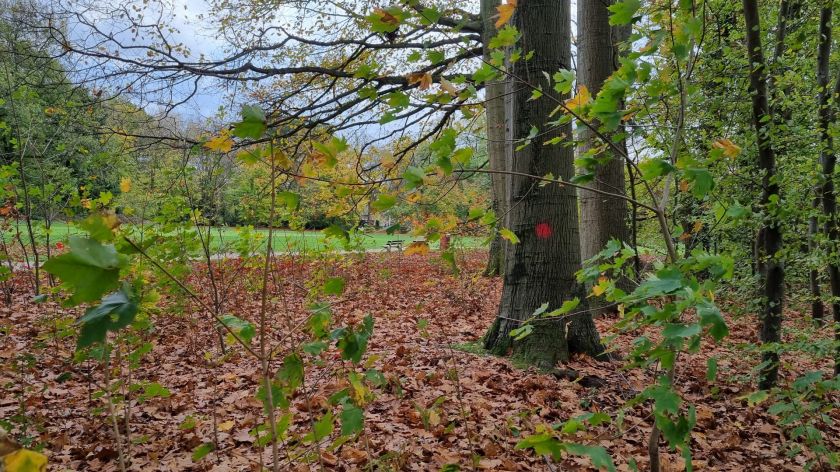Removal of 200 trees from Brakkenstein park intended to increase appeal
-
 Een boom met rode stip op de nominatie om gekapt te worden. Foto: Mathijs Noij
Een boom met rode stip op de nominatie om gekapt te worden. Foto: Mathijs Noij
Over 200 trees in Brakkenstein park are set to be removed. According to the municipality, it’s part of required park maintenance, but others think that is an outdated vision.
The municipal plans to revitalise the Brakkenstein park state the intent to fell 203 trees. According to the municipal council, this is necessary in order to maintain the existing park lanes.
The plans are motivated by the desire to future-proof the park and create -or restore- greenery. ‘The majority of the trees set to be cut down are trees that hinder the growth of other trees along the lanes, or ones that make replanting impossible’, according to Thijs Oude Nijhuis, forester for the Nijmegen municipality.
The shrubbery near the lanes was originally intended for lumber; the trees there were shorter than the birch trees along the lanes. But those trees have long since disappeared and larger trees, with thin trunks and few low-hanging branches, have taken their place. These inhibit the growth of the birch trees, as well as prevent the planting of new trees. The trees set to cut down have now been marked with red dots.
Worn-out park
‘The value of flora and fauna is in the diversity of vegetation at different elevations’, as stated by Oude Nijhuis. ‘That diversity is absent right now. The park feels very worn-out to visitors. Just like in a forest, we need to establish some variation of greenery, as well as a nice transition from low to high along the edges. The park needs to be filled with native plants, which require space.
‘I’m not in favour of cutting down healthy trees’
The park dates back to the 18th century, and for the longest time it was part of the ‘Brackesteyn’ estate; the current open structure was established in the 20th century. From 1966 onwards, the park belonged to the Nijmegen municipality and was opened to the public. Originally, the park was a so-called ‘star forest’: it was divided by lanes converging in the centre.
The Brakkenstijn district council wants more information before they will sign off on the plan. ‘However, I’m not in favour of cutting down healthy trees’, says council member Annelies de Wildt. ‘These days everyone is concerned with biodiversity and nature; it’s doubtful that the park’s appeal is more important.’
Zeitgeist
Jan Jansen, an expert on vegetation associated with Radboud University, also questions the municipal plans. ‘Historically, you can see a development in the zeitgeist, and in what we think of nature and gardens. The park is an example of three different approaches, which is a rather unique situation. Firstly, there’s the very formal style of the star forest, coupled with the wilder English landscaping style and finally the educational parks (where visitors can learn about nature, ed.) which were applied by Victor Westhoff in what is now called the Hortus’, as stated by Jansen, who is also a board member for the Hortus, but is currently speaking personally.
Jansen has noticed that fare much better than the ones along other lanes in the park. ‘That could be due to the soil and proximity to the Hortus. Birches need to be neither too wet nor too dry; they also don’t like a lot of light. That means that removing neighbouring trees might have an adverse effect.’
Healthy oak
Jansen mainly wonders if it’s keeping up with the times to maintain a park this strictly. ‘Should you cut down a healthy oak tree because there’s a birch tree next to it? If you let the trees grow as-is, the lane structure will continue to exist anyway. In my opinion, we should strive for a more natural situation, where the development of various plants is facilitated. But landscape- and garden architects are often of a different mind.’
Because the park is a national monument, any permits for the plans still need to be examined by the Cultural Heritage Agency.



